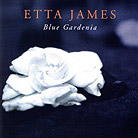March 2002
To say that this is an interesting album would be a gross understatement. Yet, to call it only interesting would be slighting its charms. Ms. James, singing jazz, strongly evokes Billie Holiday and her blues stylings. This album reminds us of how close the two forms once were. Ms. James is backed by some stellar jazz musicians: Cedar Walton on piano, Josh Sklair on guitar, Tony Dumas on bass, and Red Holloway on tenor sax, among others. Walton arranged all but one of these tunes, so the jazz sound is inevitable. However, the presentation is pure Etta James. From the first cut, "This Bitter Earth," you can hear and feel the blues invest this music. When she gets to the Duke Ellington perennial, "In My Solitude," you’ll hear this song as perhaps you’ve never heard it before -- as a churchy, gospel tune. Other songs given the jazz/blues treatment are "There Is No Greater Love," "Come Rain Or Come Shine," "Cry Me A River," and "My Man," among others. The ability to turn these aging standards into new and interesting tunes is a gift that can only come from a singer with Ms. James' vast experience. If she’d have sung these songs straight, the result would have been unremarkable. That’s been done before (and probably will be again, I’m sure). But these interpretations are neither pure blues nor gospel songs, either. As for the sound, well, that’s something of a mixed blessing. This is a digital recording; the liner notes speak of using a Euphonix R-1 Digital Multitrack Recorder, a Euphonix System 5 Digital Console, and a System 6000 effects processor from TC Electronics. It also mentions that it was surround-sound processed, although there is no indication that the CD was mastered that way. (And guess who the mastering engineer was: Charlie Watts. Cool, huh?) Ms. James' voice is clearly presented; yet, there is a filmy quality that overlays the music and obscures that you-are-there feeling. Walton’s piano, while well-recorded, is too wide for the soundstage, which, by the by, stretches only from speaker to speaker (there is, however, some depth present). The bass is deep, but loosens the lower it goes. The tenor sax, though, shines through in all its breathy glory. So let’s get back to that word-association game. Now, if I say Blue Gardenia, what do you think of now? Jazz? Blues? Gospel? Soul? That's right -- all of the above. This is an album that will surprise many of Etta James' older fans. What there is, though, is a true professional showing all her talent, taking songs we’ve known for years and presenting them to us from a truly new perspective. This is an album to be savored. Please take the time to do so. GO BACK TO: |
 Etta James - Blue Gardenia
Etta James - Blue Gardenia![[Reviewed on CD]](../format/regcd.gif) Let’s
do a little word association, shall we? When someone mentions the name Etta James, what's
the first thing that comes to mind? The blues? Well, sure. Etta is one of the leading
ladies (one might even call her the matriarch) among today’s female blues singers.
But she's just not generally considered a jazz singer -- and yet, that’s what she's
doing here. Blue Gardenia is an album of jazz standards played with the support of
real, honest-to-goodness jazz musicians, sung by Etta James, blues singer. Well, well.
Let’s
do a little word association, shall we? When someone mentions the name Etta James, what's
the first thing that comes to mind? The blues? Well, sure. Etta is one of the leading
ladies (one might even call her the matriarch) among today’s female blues singers.
But she's just not generally considered a jazz singer -- and yet, that’s what she's
doing here. Blue Gardenia is an album of jazz standards played with the support of
real, honest-to-goodness jazz musicians, sung by Etta James, blues singer. Well, well.